08: Gaffing
Between The Lines - Ch 08: Training
|
Using gaffs is certainly not as common as it once was, and may one day become redundant as respect and consideration increases for the creatures of the sea. Even if you think you will never use them, they are still tools worth having on the boat if only for nostalgic reasons, and perhaps there may be cause to use them at some stage. Naturally, if you're going to have them onboard you should know the basics of using them, and as you may have guessed, includes a bit of practice. The most common gaff is the Fixed Head (Fig 1) which is a hook on the end of a pole and the easiest to use. When using any gaff, gloves with a non-slip grip should be worn as most species will try to surge away. A good kit would include several gaffs of various head gapes for different sized fish. That is 4-inch for fish up to 25Kg, 6-inch for fish up to 35kg and 8-inch for fish over that size. Fixed head gaffs are the easiest to use, as all you have to do is aim the point at the target, which is normally the jaws, head or in the area of the gills on smaller, easily lifted fish, or in the shoulder (Fig 2) of larger fish where there may be cause for concern. Pull it in with enough power to sink the point, which of course should be sharp, and keep lifting in as smooth an action as possible. (Vid 1) Note the action is not a swing at the fish. Just aim, and pull it in and lift. The limitation of the Fixed Pole Gaff is you have to hang onto it and some fish are remarkably powerful for their size, which can result in the gaffman losing the fish and the gaff.
As with any gaff, there must be extreme caution in handling them on a busy, rolling deck. Hold the gaff point high above head height or over the side of the boat. Once a fish is gaffed care is still necessary, as the gaff point is usually aimed at the boat and crew, and severe damage to either may easily occur. Extreme caution is necessary until the gaff is stowed. The Flying Gaff (Fig 2) is a rope with a gaff hook connected at one end and the boat to the other. If you think of them in those terms, you will find learning to use it is simple. They are used on fish that are likely to be hard to hang onto with a fixed head gaff regardless of the fish's size. Flying gaffs are available in quite small sizes of around 4-inches, but the average size used is 6 and 8-inches. It is much simpler to use small flying head gaffs as they are light and easier to balance. When you learn how to use them, one of 6-inches is ideal. Points to note with flying gaffs are that the easier the flying gaff head comes out the pole the better. The pole is only a guide to aim the flying gaff head as pulling on the rope is what sets the gaff. As soon as the gaff head is entering the fish, the pole should be removed and discarded as quickly as possible. Do not use the gaff until the other end is tied to the boat, being careful to make sure that wherever it is tied is strong enough to take the enormous pressure the rope may exert. By far the most important point is to make sure there is no chance of anyone getting caught in between the rope and the gunwale of the boat as severe injury can be caused by the 'squeeze'. As accidents do happen, the gaffman should wear a knife to easily cut the rope in case something goes wrong. The crew should run through the exercise (Vid 2) of using the gaff so they will have a better understanding of where to be and what to do when the action starts.
Learning to use a small flying gaff is a good introduction to the way they work. That said, it is more than likely the fish you will want to use the gaffs on, is that once in a lifetime monster. For that, you need very big, very strong gaffs, most of which are also very heavy. If you are seriously ever going to use a large gaff such as the 10 or 12-inch Top Shot Gaff you will have to practice using them. These gaffs have barbs on the points, as do many others. Once that point is sunk, it will not come out easily. If it is a bad gaff shot, you are stuck with the chance of it ripping out. If you practice, aiming the point and removing the pole there will certainly be fewer problems.
Once you have done the exercises outlined above and are confident in using gaffs, try to increase your ability by using targets within reach but at different depths, say two and five feet, as often your target will not cooperate by staying on the surface next to the boat. One other complication is when you do use the gaffs the target is rarely stationary - the fish may be swimming and the boat should be moving forward. Use the movement to help pull the gaffs in, noting that you may have to control the gaffs against the pressure of the water to either follow the fish or control the gaffs against the water pressure as the boat moves forward. Although you can have thirty feet of gaff rope according to the rules, loose rope at these times is dangerous. During the exercises work out the maximum length of rope you will need by extending the gaffs as far as you can reach from each of the boat corners, and trim the ropes to that length. Note the rope should be cleated off during the exercises as it should be in action. In the exercises, you may become aware that the best place to tie the ropes off is the base of the game chair. If this is the case, this area may need reinforcing and extra strengthening bars or large plates fitted under the chair On very large fish, several gaffs may be needed. The first is aimed at the shoulder around the back of the gill area to the shoulder under the dorsal and the next in the middle of the fish. Note that there are many good, very strong, smaller gaffs in 6-inch and 8-inch that will hold on a large fish, but certainly the closer you can sink the gaff into the lateral line, the better the chances of holding the fish and not ripping out. With the Top Shot Gaff system, a twin rope system (Fig 4) can be set up as a double precaution against ripping cleats out, but extreme caution is necessary to ensure no-one can be caught between the ropes and that it is not used on fish that are likely to roll. In all cases, a tail rope is put on the fish as soon as possible which is cleated off to the boat with the tail up tight to the side of the boat to restrain the fish. Handling large fish is dangerous regardless of how much practice you have done. Take care and plan your actions. We often talk about the quality of fishing tackle, and gaffs are no different. Poor quality gaffs bend easily, they are difficult to get out of the pole and their components corrode, all of which make them quite dangerous to use. If you are seriously ever considering using a gaff, ensure that it is of the highest quality possible. |






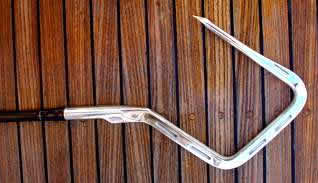
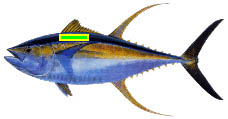
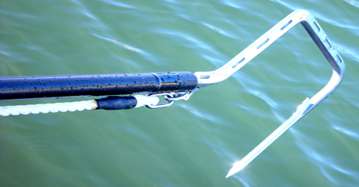
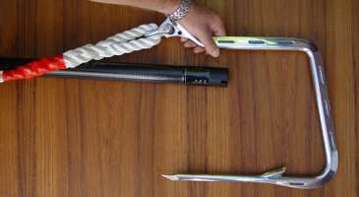
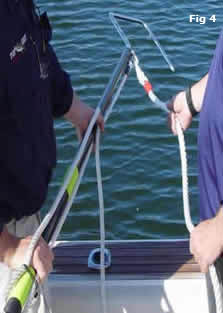 base. There should also be a restraint to stop the rope sliding up the chair pole. The ropes should be done up tightly to stop any jerking as they come tight.
base. There should also be a restraint to stop the rope sliding up the chair pole. The ropes should be done up tightly to stop any jerking as they come tight.